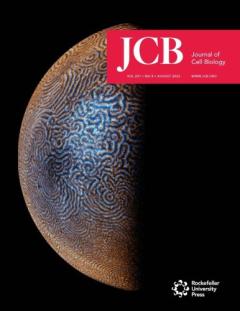New paper featured on cover of Journal of Cell Biology
A versatile cortical pattern-forming circuit based on Rho, F-actin, Ect2, and RGA-3/4
Andrew Goryachev, Professor of Computational Cell Biology and SynthSys member, is among the team of researchers whose work features on the August 2022 cover of the Journal of Cell Biology.
Michaud et al. identify Ect2 and RGA-3/4 as core components of the cortical excitability circuit associated with cytokinesis.
Additionally, they demonstrate that the immature Xenopus oocyte is a powerful model for characterizing excitable dynamics.
The image is a single frame from a light sheet movie of an immature frog oocyte exhibiting induced cortical waves of Rho activity (cyan) and actin filaments (orange). The waves are manifestations of a cortical pattern-forming circuit based on Rho, actin filaments, the Rho GEF Ect2 and the Rho GAP RGA-3/4. This conserved, versatile circuit controls cortical behaviors ranging from pulsed contraction to cytokinesis.

This work is part of a long-term collaboration attracting BBSRC-NSF/BIO funding. A £500,000 award funds the UK part of the collaboration with the US partner, Prof. W. Bement, University of Wisconsin-Madison, to work on the control of cellular pattern formation in the synthetically rewired frog oocytes.
See Prof Andrew Goryachev awarded BBSRC-NSF/BIO grant in synthetic biology
Paper
A. Michaud, M. Leda, Z. Swider, S. Kim, J. He, J. Valley, J. Huisken, J. Landino, A. Goryachev, G. von Dassow, W. Bement, A versatile cortical pattern-forming circuit based on Rho, F-actin, Ect2, and RGA-3/4. J. Cell Biol., 221(8):e202203017, (2022)

